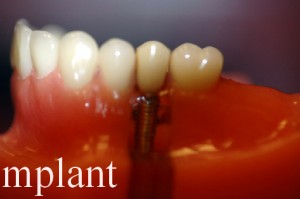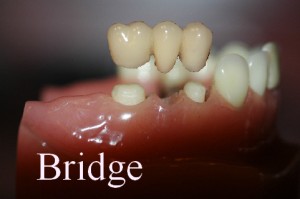Chances are, if you are an American adult, you either know somebody who has lost a permanent tooth or you have lost a tooth yourself. 69% of all Americans will have experienced tooth loss by the age of 44.
Tooth loss has a huge impact on quality of life, overall health and self-esteem. If you are missing teeth, you are likely

Dental Implant
self-conscious about the way you smile, talk, laugh and even about what you eat. In the past, dentists would recommend replacing missing teeth with a dental bridge, partial denture of complete denture. These treatments are appropriate for some patients, however, the complications and shortcomings associated with non-permanent tooth replacement can open up a brand new set of dental problems.
The biggest problem with non-permanent solutions for missing teeth involves bone loss. In a normal, healthy jaw, your bone surrounds the tooth roots, preserving the height and width of the bone. When tooth loss occurs, the bone tissue no longer has a tooth root to hold on to, so it begins to recede. Over time, the jaw bone may shrink extremely, giving the appearance of a “sunken” or “puckered” face. When bone loss occurs, so do problems with dental bridges, partial and complete dentures.

Dental bridge
Dental bridges for tooth replacement involve placing a false tooth in between crowns on adjacent teeth. Over time, bone loss occurs and the jaw bone recedes in the area of the missing tooth, creating a hygiene problem and often, breakdown of the anchor teeth due to decay or periodontal infection. While an appropriate treatment option for some patients, a dental bridge often involves the placement of a dental crown on an otherwise healthy tooth. The anchor teeth are further compromised by the increased load distributed by the false tooth as well as being more difficult to keep clean.
Partial and complete dentures for tooth replacement inhibit function and can become loose and difficult to wear over time. A partial denture attaches to remaining teeth with a clasp. The pressure of biting and chewing is distributed to the remaining teeth, applying additional stress on the anchor teeth. Over time, bone loss and stress can cause the breakdown of the anchor teeth and lead to more tooth loss. Bone loss in the area of missing teeth can also cause the partial denture to fit improperly as the jaw shape changes and the partial denture remains the same.
Complete dentures also have a tendency to become ill-fitting over time, causing the denture to become loose and inhibiting function. Many patients who wear a complete denture complain of painful sores and ulcerations on the gum tissue which inhibits use of the denture.
Dentures that slip, click or move upon talking, eating, smiling and laughing are embarrassing and uncomfortable. Complete dentures sit on top of the jaw bone, applying pressure to the entire ridge, and can speed up the process of bone loss and the “sunken” appearance associated with old age. Many denture wearers are non-compliant about wearing their dentures since they are uncomfortable, unstable and loose. Dentures which inhibit a patient’s ability to eat and chew can lead to nutritional and overall health concerns.
Replacing missing teeth with dental implants has become the gold standard for tooth replacement. Once a very expensive and time consuming treatment option, dental implants have become simpler, more accessible and more affordable. Dental implants for tooth replacement are used to replace a single tooth or for full mouth tooth replacement. A dental implant replaces the root of the tooth with a titanium post. This post is bio-compatible and preserves the bone surrounding it, inhibiting bone loss associated with missing teeth. A dental crown is built upon the post to replace the functional and aesthetic part of the missing tooth. Dental implants are extremely strong and durable, with a 97% success rate over nearly 50 years of research.
Multiple dental implants can be used to anchor a denture, preventing complications from loose dentures, bone loss and slippage. Dental implant retained dentures provide stability and comfort. Because the jaw bone is preserved, bone loss does not progress and cause a “sunken” appearance. Patients who have worn traditional dentures for years complain of discomfort, ulcerations, loose dentures and an inability to chew favorite foods. These patients gain an increased quality of life upon completing their dental implant procedure.
For more information about advances in implant dentistry, tooth replacement and implant dentures, contact us.

